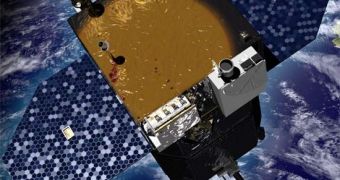Engineers at NASA have a busy schedule planned for the beginning of February. In addition to launching the space shuttle Endeavor from the Kennedy Space Center (KSC), in Florida, on the 7th, they also need to handle the lift-off of the new Solar Dynamics Observatory (SDO). The new, $800-million spacecraft will launch on the 9th from the Cape Canaveral Air Force Station (CCAFS), also in Florida. It is mounted atop an Atlas V rocket, which is set to blast off at around 10:36 am EST (1536 GMT), Space reports.
The main goal of the telescope is to determine what experts say are the most important characteristics of our Sun, such as how and why it develops its complex weather patterns. Further details about its storms could further help experts gain more knowledge on why solar flares are so powerful, and also on how they affect the upper atmosphere around our planet. “The Sun changes every time we look at it, [it] is never the same,” SDO project scientist Dean Pesnell at the NASA Goddard Space Flight Center (GSFC) explained yesterday. The GSFC is based in Greenbelt, Maryland.
Another important set of targets for observations is the change that occurs within the star, which promotes the 11-year cycle, with its periods of solar maximum and minimum. Experts hypothesize that changes in its magnetic field are to be held primarily responsible, but their level of knowledge on precisely how this happens is still relatively limited. These phenomena are the same that cause solar flares, powerful eruptions on the surface of the star that can destroy electrical grids on Earth, knock down communications, damage satellites, and jeopardize the safety of the people aboard the International Space Station (ISS).
“Our Sun affects our life more and more as we come to depend more and more on technology,” Pesnell explains. Behind all these influences is a process known simply as the solar dynamo. It is the main chain of events that promotes the development and action of the star's magnetic fields, so learning more details about it is absolutely crucial. “Understanding the dynamo, being able to predict that is the holy grail of solar physics,” SDO program scientist Madhulika Guhathakurta, from the NASA Headquarters in Washington DC, explains. “This is my baby, and it's very hard for me to push it out on its own. I am proud, I know it's going to perform, I know it's just going to be wonderful,” Elizabeth Citrin, who is the GSFC project manager for the new mission, adds about the SDO.
In order for it to be able to conduct its investigations, the telescope will feature three scientific instruments, especially designed for solar observations. The first is the Helioseismic and Magnetic Imager (HMI), whose job is to generate maps of the plasma flows that generate the star's magnetic fields. It is also in charge of mapping the magnetic fields themselves. The second instrument is the Atmospheric Imaging Assembly (AIA), which will use multiple wavelength filters to image the solar atmosphere, from infrared to ultraviolet. The HMI/AIA collaboration will link internal changes to external effects.
The third and final instrument is the Extreme Ultraviolet Variability Experiment (EVE), whose job is to measure the Sun's radiation emission levels in the extreme ultraviolet wavelengths (EUV). While, in visible light, the star shows little changes in its brightness, variations become very visible in this portion of the electromagnetic spectrum. Researchers want to take a better look at the star using this knowledge.

 14 DAY TRIAL //
14 DAY TRIAL //